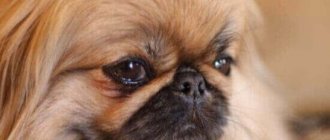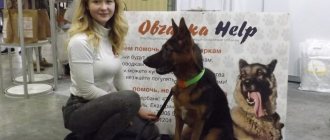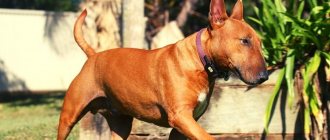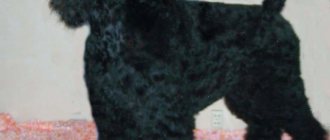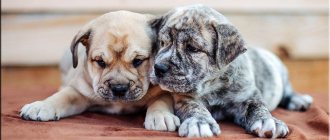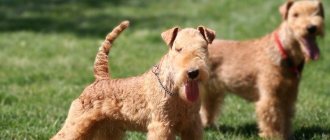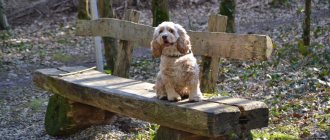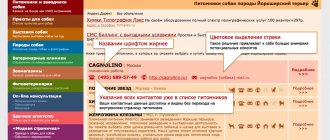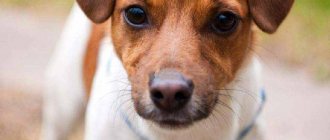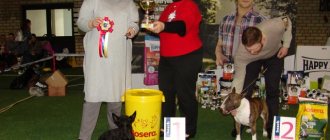Breed traits
Breed traits (on a 5-point scale)
| Border Terrier | |||
| Activity | in the house | 4 | |
| on the street | 4 | ||
| Obedience | training | 3 | |
| strangers | 3.3 | ||
| Domination | in family | 2 | |
| over dogs | 2.2 | ||
| Defending your territory | from people | 2 | |
| from dogs | 2.8 | ||
| Sociability | in family | 5 | |
| with strangers | 4 | ||
| with dogs | 3 | ||
| Concentration | in family | 1 | |
| in front of strangers | 1.6 | ||
| with dogs | 2 | ||
| Aggressiveness | in family | 1 | |
| to strangers | 2 | ||
| to the dogs | 2 | ||
| to cats | 2 | ||
| Family behavior | calmness | 4 | |
| demand for affection | 4.7 | ||
| excitability | 4 | ||
| playfulness | 4.3 | ||
| excessive barking | 2 | ||
| behavioral breakdowns | 2 | ||
| Tolerance for children | up to 4 years | 3.5 | |
| over 4 years old | 4 | ||
| Institutional use | watchman | 3.4 | |
| bodyguard | 1.6 | ||
This breed is often compared to the following dog breeds: Bedlington Terrier, Australian Terrier, Beagle, Affenpinscher, Miniature Schnauzer (Dwarf Schnauzer).
The photo shows what a border terrier looks like:
General characteristics of the breed
The name Border Terrier comes from a combination of English words that translate as “border” and “burrow dog.” Representatives of the breed are also called border terriers or border terriers. This dog is short in stature, has long paws and has rough fur. This helped him climb into any holes, keep up with horses, running under them. This dog is strong, resilient, agile and fearless.
Now Border Terriers are rarely used for hunting, but they have retained their working qualities. These dogs are popular as companions. This is a real terrier - energetic, strong and cheerful. The pet is perfect for an owner who leads an active lifestyle. He is smart, not aggressive, and gets along well with children.
Due to their balanced, cheerful character, responsiveness and sociability, Borders are suitable for canistherapy. These dogs are able to lift your spirits and know how to smile. They are used as assistants for the deaf and mute, to search for missing people. They show good results in agility.
| Options | Characteristic |
| breed name | border terrier |
| country of origin | Great Britain |
| group of breeds according to the ICF classification | terriers |
| application | hunter, companion |
| life expectancy | 12-15 years |
| height | 28-35 cm |
| weight | males 5.9-7.1 kg, females 5.1-6.4 kg |
| basic character qualities | friendliness, loyalty, intelligence, cheerfulness |
| activity | very high |
| intelligence | tall, easy to train |
| attitude towards a person | loyal, sociable, good with children, suspicious of strangers |
| complexity of content | requires long walking with physical activity, coat care is simple |
pros
The Border Terrier is a cheerful, sociable dog, intelligent and quick-witted. Thanks to its small size and unpretentiousness, it can be kept in a city apartment. These pets also have the following advantages:
- loyal to the owner, attached to all family members;
- love children;
- cheerful, playful;
- not aggressive;
- smart, easy to train;
- obedient, not prone to dominance;
- sensitive, responsive, understand a person’s mood;
- have innate working qualities;
- wool does not require complex care;
- get along well with other pets, except rodents.
Minuses
But these dogs are not for everyone - they require an active owner who will provide sufficient physical activity. Like other terriers they have a few faults that can become a problem:
- love to dig, make tunnels;
- they chew on everything;
- they often run away, and since they are not afraid of noise, they can get hit by a car;
- do not tolerate loneliness well, require attention from their owners, and can be persistent;
- prone to allergies and obesity.
The video complements the characteristics of the breed:
Video: Border Terrier
Video: All about Border Terrier dogs.
Origin
The breed comes from the Cheviont Hills (border between Scotland and England). Border in translation means border (hence the name of the dogs). The breed was first mentioned in the work “Dogs of the British Isles” in 1872. The image showed an aristocrat and a pack of hunting dogs.
Poor people and farmers did not keep dogs for pleasure, but rich people used them for hunting. They were constantly trying to breed the perfect terrier. The first representatives of this breed received negative reviews. At this time, people tried to breed dogs with excellent working qualities; little attention was paid to appearance. To correct this deficiency they were crossed with the Fox Terrier and the White Terrier (which currently does not exist). As a result, the appearance became better.
Due to their compact build, puppies were especially prized. In addition, dogs were used on farms as guards and rat catchers. Gradually, border artists began to be shown at local exhibitions. In 1880 they were given a name, and a year later a description of the breed was developed. In 1913, the breed standard was approved. In 1920, the Kennel Club of England recognized the breed.
Dogs make up the UK's top 20 favorite breeds.
History of the origin of the breed
The Border Terrier is a hunting dog breed that was bred in the border areas of England and Scotland several centuries ago. Some researchers believe that they were bred in the 14th century by crossing Dandy Dimont Terriers with Bedlington Terriers. According to others, the breed appeared naturally. These dogs were used to hunt foxes, badgers, martens and other burrowing animals. Farmers bred them to protect their farms from rodents.
Often these dogs hunted in packs or together with hounds. They needed to keep up with the horses and climb into hard-to-reach places. Thanks to this, representatives of the breed get along well with other dogs and are not afraid of horses. They are agile, fast and fearless, as they needed to hunt predatory animals, albeit small ones.
The specifics of using this dog breed are also associated with appearance features. Border Terriers are small in size, have long limbs, coarse short hair, and a dense undercoat that protects the skin from moisture and injury from branches. In the 18th-19th centuries, representatives of this breed were the most popular hunting dogs.
Border Terriers were officially recognized only in 1920. They have spread throughout the world, but have not become popular everywhere. Now, in addition to the UK, borders are common in the USA and many European countries. In Russia they are less known and are a rather rare breed.
Price
Buying a dog will not be difficult. It is better, of course, to contact a specialist who will confirm the purebredness and behavior of the dog. When purchasing, relevant documents must be present that confirm the pedigree.
Border Terrier puppies
There are clubs that breed and sell puppies of this breed. The price of a border terrier for one puppy, on average, will be from 30,000 to 70,000 rubles. You can buy a puppy from your own hands. In this case, you can save a lot, but, most of all, such a puppy will be of mixed breeds and its price will be no more than 20,000 rubles.
If you buy a dog from a kennel, you will have to pay from 25,000 rubles for a furry friend. If you need a purebred border dog that meets all standards, has a beautiful color and a pure pedigree, then it will cost at least 50,000 rubles.
Appearance Standard
The appearance of Border Terriers is unprepossessing and many people consider it ugly. It is a small dog with a strong build, short, coarse hair and a head resembling that of an otter. Height is 28-35 cm, males can grow up to 40 cm. The weight of a border terrier is on average 6 kg, some individuals weigh more - up to 7 kg.
Head
The skull is moderately wide, almost square in shape. The muzzle is short, the forehead is high, the transition to the nose is smooth. The jaws are strong and have a scissor or straight bite. The nose is large and black. In light-colored individuals it may be brown.
According to the standard, the eyes of a Border Terrier should be dark. Set wide apart, medium in size, should not be convex. The look is good-natured, cheerful and attentive. The ears are fleshy and small. The shape is triangular, hanging down, directed forward and pressed tightly to the head.
Frame
The physique is strong and muscular. Rectangular body. The neck is of medium length, smoothly blending into the back. The chest is narrow but deep, the stomach is tucked. The back is wide and level. The tail is set high and thick at the base. It is short and cannot be docked. The dog lifts it high, but does not put it on its back and does not twist it into a ring.
Limbs
The limbs are long and muscular. Thanks to this, boarders are able to develop great speed and run for a long time, jump high. The paws are small, the toes are collected, with thick pads.
Coat and color
The coat is thick and hard. On the muzzle it forms a characteristic beard, eyebrows and mustache. The hair on the body fits well, which helps the dog easily penetrate into any holes. The undercoat is short and dense, reminiscent of felt. It protects the dog from cold, heat, moisture, and damage.
Border Terriers are characterized by several colors:
- ginger;
- sand;
- wheat;
- pale yellow;
- zonal;
- black-and-white;
- gray and tan.
The standard allows the presence of gray hairs. But there should be no white spots; the dog will be disqualified for this. With any type of color, the muzzle and ears should be darker than the rest of the body. Another peculiarity of the breed is that puppies are born black or brown. The final color is established only after six months.
Photos complement the description of the appearance:
Characteristics of the Border Terrier
The Border Terrier is an active, hardy and fearless dog. But at home she turns into a good-natured, affectionate and sociable pet. He is cheerful, playful, always ready to play pranks. This dog is very inquisitive, he is interested in everything. To explore the world around him, he can jump or climb anywhere, dig under a fence and run away.
This dog is not aggressive at all. She is friendly with all family members, becomes attached to them, and tries to be around them all the time. She is friendly with strangers, although she is always ready to fearlessly rush to her owner’s defense. Despite its small stature, this terrier is capable of protecting the territory - it notifies with a loud bark about any intruder.
Border Terriers get along well with children, but only of school age. They enjoy playing with the child, running and frolicking. They are patient, but will not tolerate serious disrespect or pulling of the fur or tail. They can harbor a grudge and even begin to take revenge, although they will never bite. Therefore, you should not leave your dog alone with small children.
The Border Terrier is friendly with other dogs and never gets into conflicts. But if necessary, he is ready to stand up for himself. At home he gets along well with cats, although he does not tolerate rodents - as he is a born rat-catcher.
Training
Border Terriers are very smart, quick-witted, and easy to train. They are able to learn many commands in a short time. If you find the right approach to the dog, it will obey unquestioningly and react even to the gestures and movements of the owner. The first two years are important for character development. An adult, well-mannered dog does not cause any problems.
Early socialization is necessary. The puppy must get used to other dogs, strangers, and street noise. It is advisable to take your pet to dog parks where he can run and play. He will be happy to accompany his owner on runs and bike rides.
At home, you immediately need to accustom the puppy to the place, name, and routine. It is important to load him with mental and physical exercises. Out of boredom, a dog can chew furniture, shoes, and damage upholstered furniture and wallpaper with its claws. It is advisable not to leave him alone for a long time, buy a lot of toys that he can chew. The main attention should be paid to the following commands:
- to me;
- stand;
- near;
- it is forbidden;
- ugh.
The Terrier requires adherence to the regime. Training should be regular and consistent. It is advisable to diversify them and combine them with games so that the dog does not get bored. These dogs are good at learning tricks and can participate in agility, frisbee and other types of dog sports. Borderers may become distracted during a lesson and even run away if something interests them. Rudeness and physical punishment are unacceptable, but you need to encourage and praise your pet more often.
Dogs begin to be trained for hunting at 6 months. Before this, she must immediately respond to the nickname and come on command. It is advisable that such classes be conducted by an experienced hunter or dog handler. If off-leash training is carried out in an unfenced area, the dog must have a chip or an address tag.
Interesting video on how to train these dogs:
Video: Border Terrier flash agility
Video: Border Terrier training.
Video: Search for partridge - border terrier sherry (shmulya)!
Character
The Border Terrier is one of the best family pets and loves everyone's attention. They are always close to their owners and suffer greatly from loneliness. The border terrier and children quickly find a common language, but it is better not to leave children alone with the puppy, as it can inadvertently injure the baby. In general, socialization with children, people and other animals must be carried out earlier, otherwise the puppy will be too modest or too aggressive.
In European countries, these dogs work in nursing homes and rehabilitation centers.
Border is energetic, ideal for active people and will not appeal to homebodies. If you don't walk him enough and keep him locked up at home, he will become angry. You might want to consider getting a second dog or keeping one in the yard, there's plenty of fun out there. It is not recommended to keep this dog on a chain. He does not show aggression towards other dogs and reacts calmly to them. Bold and ruthless on the hunt.
It is not the best watchdog because of its friendly nature. He will bark and jump out of delight, not out of aggression. This quality will not have the best effect on home security. A Border Terrier and a cat can get along well in the house if they live together from an early age. On the street, other unfamiliar animals will be chased. It is not recommended to have hamsters and rabbits in the house where the Border Terrier lives. If you plan to have two dogs of this breed, then it is better to take opposite sexes, otherwise fights between pets are possible.
Representatives of the breed are very smart and try to please the owner. Stubborn and emotional. These qualities are important to consider when training: you should not be rude, it is better to praise and encourage the puppy.
It cannot live without physical activity, so it is important to take a long walk with your pet every day. He likes to dig, so in a private house you need to carefully inspect the fence (he may escape). When walking your dog outside, you must be on a leash. If the dog runs away, it will be almost impossible to catch him. Letting him off the leash is allowed after the dog has learned the command to come to me.
Maintenance and care
Border Terriers are not picky and easily adapt to any living conditions. They are easy to keep in a city apartment or in a private house. Just don’t put him on a chain: without communication with a person and physical activity, the dog’s character will deteriorate. It’s also not worth keeping in an enclosure, like all terriers, they love to dig, they can dig under and run away.
With any method of keeping a border terrier, he needs sufficient walking with physical activity: running, active games. You need to walk an adult dog 2 times a day for at least an hour.
Caring for this dog is easy. The coat is short and hard, no haircut is needed, although trimming is required from time to time - plucking out dead hairs. Normal hygiene procedures are required:
- It is enough to comb the coat once a week with a stiff brush or a comb with frequent teeth;
- during molting, you need to comb it daily, trimming is also advisable;
- To maintain a well-groomed appearance, it is recommended to visit a groomer several times a year;
- Before the exhibition, representatives of the breed require trimming - hair in the ears, beard, back, and limbs is plucked;
- Border Terriers love water very much, they swim in bodies of water with pleasure, but they should not be bathed often - their coat does not absorb dirt and does not emit an unpleasant odor;
- after each walk you need to wash your paws, and after eating - your mustache and beard;
- in dirty weather, it is better to put on a waterproof overall for the dog; in winter, he needs warm clothes only in severe frosts; a dense undercoat protects him from the cold;
- Clean your ears and rinse your eyes with a special lotion several times a week;
- trim the claws with a nail clipper as they grow, be sure to trim the hair between the toes;
- you need to take care of their teeth - these dogs are prone to the formation of tartar, so it is recommended to regularly give chewing bones or brush their teeth with veterinary paste.
Nutrition
These dogs love to eat and are prone to weight gain. Therefore, you should carefully choose your diet and determine the amount of food. It is especially important to ensure that your dog does not overeat if he doesn’t move much. Puppies are fed 3-4 times a day, an adult dog should be switched to two meals a day by the age of one year. Clean water must always be freely available.
With natural feeding, 70-80% of the diet should consist of meat, offal and fish. You need to choose low-fat varieties: veal, rabbit, chicken. Meat food is supplemented with cereals and vegetables. It is also useful to give fermented milk products, eggs, and add vegetable oil to food. Sweets, potatoes, flour products, smoked meats, and pickles are prohibited for dogs. You cannot give food from your table, fried or fatty foods, or season food with salt or spices.
When choosing dry food, you should give preference to hypoallergenic super-premium brands. The composition must contain at least 50% protein, preferably a minimum amount of carbohydrates, and no grains.
Health
The Border Terrier is not an artificially bred breed. Therefore, its representatives are hardy, unpretentious, and have strong immunity. They live on average 12-14 years. But with proper maintenance, a pet can live 15-16 years. Health is good, although sometimes the following diseases occur:
- heart defects;
- hypothyroidism;
- joint dysplasia;
- allergy;
- dermatitis;
- eye diseases;
- nervous diseases;
- sprains and other injuries;
- malocclusion, which provokes dental diseases.
Borders are insensitive to pain and will not whine. It is important for the owner to pay attention to any change in the pet’s behavior in order to consult a doctor in time. It is recommended to visit the veterinarian several times a year for preventive purposes. It is necessary to carry out deworming in a timely manner and receive all necessary vaccinations.
How to buy a border terrier puppy
It is better to purchase a puppy from a nursery. The breed is not very popular in our country, but responsible breeders can be found at dog shows or on dog websites. In Moscow, the cost of purebred pet-class border dogs averages 25-30 thousand rubles. Prices for puppies that can participate in exhibitions exceed 40 thousand rubles.
If you decide to buy a dog of this breed, you need to approach the choice responsibly. It is not recommended to purchase a puppy by hand or on the market; suspicion should also be aroused by the breeder’s desire to quickly sell the puppy at any price. There is a risk of purchasing a mixed breed or a dog with hereditary pathologies.
Border Terrier puppies are sold at the age of 3 months. Before choosing, you need to study the living conditions of the animals, get to know the mother and her behavior. The breeder must provide all necessary documents and veterinary certificates. He will tell you what to feed the dog and how to care for it.
When choosing a puppy, you need to pay attention to the following signs:
- he must be active, inquisitive, not cowardly;
- the limbs are thickened, without signs of dysplasia, the gait is confident;
- the physique is proportional;
- the coat is shiny, without bald spots;
- eyes are clean, without discharge;
- nose is wet and cold.
The photo shows what the puppies look like:
The video complements the description of the breed:
Video: All about the Border Terrier breed
Video: Border Terrier. Pros and cons, price, how to choose, facts, care, history
The Border Terrier is a cheerful and good-natured pet. He can become a teenager's best friend, a devoted companion. This is an ideal family dog, an apartment pet, unpretentious and obedient. But he needs to pay a lot of attention. The breed is not suitable for homebodies, people leading a sedentary lifestyle, or those who are constantly away from home.
Nutrition
The Border Terrier breed is not picky about food, but there are several recommendations that must be followed:
— dogs need a properly balanced diet;
- half of the diet should consist of protein foods, since they are very mobile and spend a lot of energy and strength;
- tubular bones, fatty meats and cereals, dishes with spices, sweets, smoked and pickled foods are prohibited;
- you cannot give them foods that cause fermentation processes in the body;
— it is recommended to feed 5-6 times a day, but not in large portions;
— before introducing a new product, it is imperative to check the animal for allergies. To do this, you need to give a little product and observe the dog for several days;
- do not tolerate bread and potatoes well; the latter is best eaten as a puree;
- it is necessary to often give cottage cheese, fermented milk products, quail eggs, vegetables;
- lean pork, beef should be present in the diet every other day. Meat is necessary to maintain muscle tone and normal function;
— a good solution would be to feed your pet with special top-class food;
- It is necessary to give special vitamins that maintain bones and teeth in normal condition.
